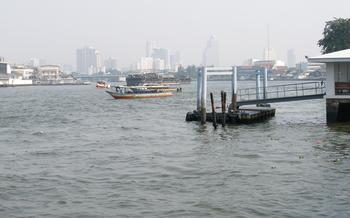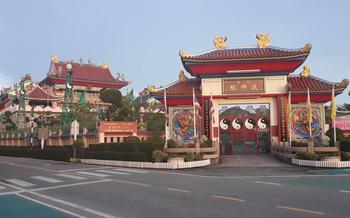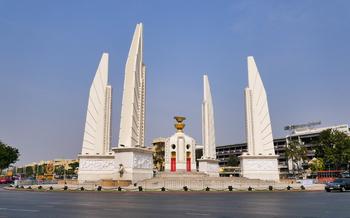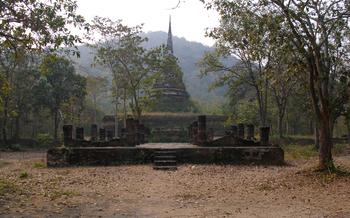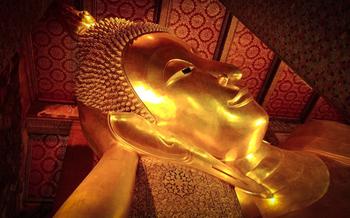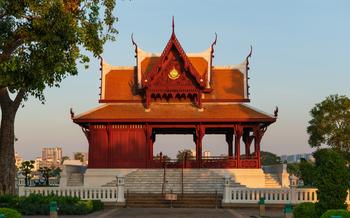
Dusit Palace
- Dusit Palace: A Historical Landmark in Bangkok
- Exploring the Dusit Throne Hall
- Marveling at the Ananta Samakhom Throne Hall
- Strolling Through the Royal Plaza
- Visiting the Vimanmek Mansion
- Admiring the Abhisek Dusit Throne Hall
- Exploring the Dusit Zoo
- Learning about the Dusit Museum
- Witnessing the Changing of the Royal Guard Ceremony
- Taking a Guided Tour of the Palace
- Photography Tips for Capturing the Palace's Beauty
- Tips for Planning Your Visit
- Nearby Attractions and Activities
- Accommodation Options Near the Palace
- Insider Tip: Unveiling the Hidden Gems of Dusit Palace
Dusit Palace: A Historical Landmark in Bangkok
Dusit Palace stands as a testament to the rich history and cultural heritage of Thailand. Built in the late 19th century by King Chulalongkorn (Rama V), the palace served as the official residence of the Thai royal family for over a century. Its architectural grandeur, symbolic significance, and historical importance make it a must-visit destination for travelers seeking a deeper understanding of Thai culture and monarchy.
The palace complex encompasses several magnificent buildings, including throne halls, mansions, museums, and landscaped gardens, each showcasing unique architectural styles and historical narratives. Whether you're a history buff, an architecture enthusiast, or simply seeking a glimpse into the life of the Thai royal family, Dusit Palace offers a captivating journey through Thailand's regal past.
Exploring the Dusit Throne Hall
The Dusit Throne Hall holds a significant place in Thai history. Built in 1897 during the reign of King Chulalongkorn (Rama V), it served as the primary audience hall for the king and his court. In its early years, the throne hall witnessed numerous important events, including royal ceremonies and the reception of foreign dignitaries.
Architecturally, the Dusit Throne Hall is a blend of traditional Thai and European styles. The exterior features intricate carvings and decorations, while the interior is adorned with grand chandeliers and opulent furnishings. The throne hall is also notable for its massive size, with a capacity to accommodate over a thousand people.
Today, the Dusit Throne Hall is primarily used for ceremonial purposes, such as the annual Changing of the Royal Guard Ceremony. It is also open to the public for guided tours, offering visitors a glimpse into the grandeur and history of the Thai monarchy.
Here are some highlights of the Dusit Throne Hall:
- The intricate carvings on the exterior depict scenes from Thai mythology and history.
- The interior is adorned with grand chandeliers and opulent furnishings.
- The throne hall is surrounded by a moat and lush gardens, creating a picturesque setting.
- The throne hall is still used for important royal ceremonies and events.
- Guided tours are available for visitors to learn more about the history and significance of the throne hall.
Marveling at the Ananta Samakhom Throne Hall
At the heart of the Dusit Palace complex stands the majestic Ananta Samakhom Throne Hall, an architectural masterpiece and a testament to Thai royal grandeur. Completed in 1915, this grand palace was commissioned by King Rama V to serve as a venue for state functions, royal ceremonies, and official receptions.
Inspired by Italian Renaissance architecture, the Ananta Samakhom Throne Hall boasts an awe-inspiring facade adorned with intricate carvings, elegant arches, and towering columns. Its grand entrance leads to a spacious interior, where visitors are greeted by a breathtaking display of opulence and grandeur. The walls are lined with intricate murals depicting scenes from Thai history and mythology, while the ceiling is adorned with exquisite chandeliers and delicate plasterwork.
This magnificent throne hall has witnessed countless historical events, including the signing of the 1932 Constitution that transformed Thailand into a constitutional monarchy. Today, it continues to be used for important state occasions and royal ceremonies, such as the annual Royal Ploughing Ceremony and the King's Birthday Celebration.
Visitors to the Ananta Samakhom Throne Hall can embark on a guided tour to explore its opulent interiors, learn about its historical significance, and witness the grandeur of Thai royalty up close. This architectural masterpiece is a must-visit for anyone interested in Thai history, culture, and architecture.
Strolling Through the Royal Plaza
The Royal Plaza, also known as Sanam Suea Pa, is an expansive and meticulously landscaped garden located at the heart of the Dusit Palace complex. Visitors can take a leisurely stroll through the well-maintained paths, admiring the vibrant flowerbeds, lush greenery, and towering trees that adorn the grounds.
Throughout the plaza, one will encounter a series of historical monuments and statues that pay homage to important figures and events in Thailand's history. These include the equestrian statue of King Chulalongkorn, the founder of the Dusit Palace, as well as monuments commemorating the country's victories in various wars.
The Royal Plaza serves as a venue for a variety of public events and celebrations, including traditional Thai festivals, military parades, and cultural performances. Locals and tourists alike gather here to witness these vibrant displays of Thai heritage and history.
In addition to its historical and cultural significance, the Royal Plaza is also a popular spot for leisure activities. Families can enjoy a picnic lunch on the grassy lawns, while joggers and cyclists take advantage of the designated paths that wind through the gardens. The tranquil atmosphere and picturesque surroundings make the Royal Plaza an ideal place to relax and escape the hustle and bustle of Bangkok city life.
Visiting the Vimanmek Mansion
Nestled within the sprawling grounds of the Dusit Palace, the Vimanmek Mansion stands as a testament to Thai craftsmanship and architectural ingenuity. Constructed entirely of golden teakwood, this magnificent structure holds the distinction of being the world's largest teakwood building. Its intricate carvings and elegant design reflect the grandeur and opulence of the Thai monarchy.
As you approach the Vimanmek Mansion, its sheer size and intricate details are sure to captivate your attention. The mansion comprises 31 different pavilions, each showcasing a unique architectural style and adorned with exquisite carvings and embellishments. The intricate fretwork, gables, and spires create a harmonious blend of traditional Thai and European influences.
Inside the mansion, you will discover a treasure trove of artifacts and exhibits that provide a glimpse into the history and culture of Thailand. The rooms are adorned with antique furniture, royal portraits, and personal belongings of the Thai royal family. The mansion's collection includes rare manuscripts, ceremonial objects, and artwork that offer a fascinating insight into the lives of Thailand's former monarchs.
Guided tours are available to provide visitors with a comprehensive understanding of the mansion's history and significance. Knowledgeable guides will lead you through the various pavilions, explaining the architectural features, historical context, and cultural importance of each space. They will also share stories and anecdotes about the royal family, offering a glimpse into the lives of those who once resided within these walls.
Whether you are a history buff, an architecture enthusiast, or simply someone who appreciates beauty and craftsmanship, the Vimanmek Mansion is a must-visit destination. Its unique blend of history, culture, and architectural splendor makes it an unforgettable experience that will leave you in awe.
Admiring the Abhisek Dusit Throne Hall
Erected in 1904, the Abhisek Dusit Throne Hall is a stunning testament to the grandeur of the Thai monarchy. Its construction marked the occasion of King Chulalongkorn's (Rama V) Diamond Jubilee, celebrating 60 years of his reign. This architectural marvel serves as a venue for significant royal ceremonies and events. The throne hall's intricate carvings, opulent interiors, and majestic pillars reflect the exquisite artistry of Thailand's master craftsmen. Visitors can embark on guided tours to delve into the history, symbolism, and cultural significance of this architectural masterpiece, gaining insights into the rich traditions of the Thai royal court.
Exploring the Dusit Zoo
Embark on a captivating journey through the vibrant world of wildlife at the Dusit Zoo, a beloved attraction nestled within the sprawling grounds of Dusit Palace. Established in 1938 by King Rama VII, this enchanting zoo is home to a diverse array of animal species from around the globe, providing visitors with an immersive experience that sparks curiosity, wonder, and a deep appreciation for the natural world.
As you wander through the zoo's meticulously landscaped enclosures, encounter majestic elephants, graceful giraffes, playful monkeys, and a myriad of other fascinating creatures. Observe their unique behaviors, learn about their habitats and conservation status, and gain a deeper understanding of the delicate balance that sustains our planet's biodiversity.
The Dusit Zoo is not merely a place of entertainment; it is also a hub for education and conservation. Participate in interactive educational programs designed to raise awareness about wildlife protection and the importance of preserving our natural heritage. Witness the zoo's ongoing efforts to protect endangered species and contribute to global conservation initiatives.
Families with children will find the Dusit Zoo to be an ideal destination, offering a blend of fun, education, and adventure. Engage in hands-on activities, attend animal shows and demonstrations, and create lasting memories as you explore the wonders of the animal kingdom together.
Whether you are a wildlife enthusiast, a conservation advocate, or simply seeking a delightful day out with loved ones, the Dusit Zoo promises an unforgettable experience that will leave you inspired, informed, and deeply connected to the natural world.
Learning about the Dusit Museum
The Dusit Museum, housed within the former residence of Prince Narisara Nuwattiwong, provides visitors with a fascinating glimpse into the history and culture of the Dusit Palace and the Thai monarchy. Its collection of artifacts, exhibits, and displays offers a comprehensive exploration of the palace's significance and its role in shaping Thailand's history.
Historical Exhibits: The museum showcases a range of historical exhibits that delve into various aspects of the palace's past. Visitors can learn about the construction of the palace, the lives of its royal inhabitants, and the major events that have taken place within its walls.
Royal Artifacts: Among the highlights of the museum are the collection of royal artifacts, including personal belongings, furniture, and ceremonial objects that once belonged to the Thai monarchs. These artifacts provide a glimpse into the lifestyle and traditions of the royal family.
Cultural Displays: The museum also features cultural displays that explore Thai customs, traditions, and rituals associated with the palace. Visitors can gain insights into the unique ceremonies, festivals, and performances that have been held at the Dusit Palace over the centuries.
Guided Tours: To enhance the visitor experience, the Dusit Museum offers guided tours that provide in-depth explanations and historical context for the exhibits. These tours allow visitors to ask questions and gain a deeper understanding of the palace's rich history.
Witnessing the Changing of the Royal Guard Ceremony
A spectacle not to be missed when visiting Dusit Palace is the Changing of the Royal Guard Ceremony. This historical tradition takes place every day at 10:00 am in front of the Ananta Samakhom Throne Hall. It is a solemn and colorful event that showcases the precision and discipline of the palace guards.
The ceremony begins with the arrival of the Royal Guard Band, marching in formation with their traditional musical instruments. They perform various military marches and tunes, setting the stage for the changing of the guard.
The old guard, dressed in their ornate uniforms, marches out of the palace grounds, while the new guard, in their equally impressive attire, marches in. The two groups exchange salutes and positions, marking the official transfer of duty.
The highlight of the ceremony is the synchronized movements of the guards as they perform a series of intricate drills and formations. The precision and coordination of their actions are a testament to the rigorous training they undergo.
Visitors to the palace can witness this spectacle from designated viewing areas around the Ananta Samakhom Throne Hall. It is an excellent opportunity to capture some stunning photos and videos, especially during the early morning light.
Remember to arrive early to secure a good viewing spot and to be respectful during the ceremony by maintaining silence and following any instructions provided by the palace staff.
Taking a Guided Tour of the Palace
Enrich your visit to the Dusit Palace by embarking on a guided tour, an excellent way to delve deeper into the history, architecture, and cultural significance of this royal complex. Knowledgeable guides will lead you through the various halls, courtyards, and gardens, providing insights and anecdotes that bring the palace to life.
Guided tours are available in various languages and offer a range of options to suit different interests and time constraints. Whether you prefer a comprehensive overview or a focused exploration of a specific area, there's a tour designed to meet your needs.
To book a guided tour, you can either make reservations in advance through the palace's official website or inquire at the visitor center upon arrival. It's advisable to book ahead, especially during peak tourist seasons, to secure your preferred time slot.
During the tour, remember to ask questions and engage with your guide. Their expertise will enhance your understanding of the palace's significance and help you capture the essence of this remarkable historical landmark.
Photography Tips for Capturing the Palace's Beauty
Capturing the grandeur and beauty of Dusit Palace through the lens of a camera requires careful consideration of various photography techniques. To ensure stunning shots, opt for a camera with a wide-angle lens to accommodate the vast expanse of the palace grounds. Utilize a tripod for stability, especially when shooting in low-light conditions. Experiment with different shutter speeds to capture the movement of clouds or flowing water features.
When it comes to lighting, the golden hours of sunrise and sunset offer the most flattering light for photography. Position yourself strategically to capture the palace against the backdrop of a vibrant sky. Pay attention to the direction of light to avoid harsh shadows. Utilize natural light filters, such as trees or clouds, to soften the sunlight and create a more diffused effect.
Composition is key to creating visually appealing photographs. Experiment with different angles and perspectives to find unique viewpoints. Incorporate elements of the foreground, such as flowers or statues, to add depth and interest to your shots. Utilize leading lines, such as pathways or columns, to draw the viewer's eye towards the main subject.
Post-processing software can enhance the colors and tones of your photographs, bringing out the intricate details of the palace's architecture. Experiment with adjustments to contrast, saturation, and white balance to achieve the desired look and feel. Consider using HDR (High Dynamic Range) techniques to capture the full range of light and shadow in your images.
Tips for Planning Your Visit
To make the most of your visit to the Dusit Palace, careful planning is essential. Here are some tips to ensure a smooth and enjoyable experience:
Ideal Time to Visit:
The best time to visit the Dusit Palace is during the cooler months from November to February when the weather is pleasant, and the crowds are relatively smaller. However, the palace is open year-round, and each season offers its unique charm.
Dress Code and Etiquette:
As a visitor to the Dusit Palace, it is important to dress respectfully. Avoid shorts, tank tops, and revealing clothing. While photography is generally allowed, be mindful of the signs and avoid taking pictures in restricted areas.
Accessibility for Visitors with Disabilities:
The Dusit Palace has made significant efforts to ensure accessibility for visitors with disabilities. Wheelchair ramps and elevators are available in most areas, and there are designated parking spaces for visitors with disabilities.
Facilities and Services Available:
The Dusit Palace offers various facilities and services to enhance the visitor experience. These include restrooms, drinking fountains, a first-aid station, and a souvenir shop. Guided tours in different languages are also available upon request.
Nearby Attractions and Activities
Dusit Palace is surrounded by a wealth of attractions that offer a glimpse into Bangkok's rich history, culture, and modern-day vibrancy.
-
Grand Palace and Wat Pho: Just a short distance from Dusit Palace, the Grand Palace is a must-visit for any visitor to Bangkok. This sprawling complex houses the Temple of the Emerald Buddha, considered the most sacred Buddhist temple in Thailand. Wat Pho, located nearby, is renowned for its giant reclining Buddha, measuring an impressive 46 meters in length.
-
Chinatown: Bangkok's Chinatown is a bustling neighborhood known for its vibrant street markets, delicious street food, and traditional Chinese temples. Visitors can explore the narrow alleys, sample local delicacies, and shop for souvenirs and antiques.
-
Khao San Road: This famous backpacker hub is located a short walk from Dusit Palace. Khao San Road is lined with budget-friendly guesthouses, lively bars, and restaurants catering to travelers from around the world.
-
MBK Center: For those who enjoy shopping, MBK Center is a massive shopping mall located near Dusit Palace. The mall features a wide range of shops, from international brands to local boutiques, as well as a food court and a cinema.
-
Jim Thompson House: This former residence of an American silk merchant is now a museum dedicated to Thai silk and traditional Thai architecture. Visitors can learn about the history of silk production in Thailand and admire the beautiful collection of silk textiles on display.
Accommodation Options Near the Palace
There are various accommodation options available near the Dusit Palace, ranging from budget guesthouses to luxurious hotels. Here are a few recommended options:
The Siam: Located just a short walk from the palace, The Siam is a renowned luxury hotel known for its elegant and stylish accommodations.
Mandarin Oriental, Bangkok: Another prestigious hotel near the palace, the Mandarin Oriental offers stunning views of the Chao Phraya River and world-class amenities.
The Peninsula Bangkok: Situated on the banks of the Chao Phraya River, The Peninsula Bangkok is a historic hotel offering spacious rooms and suites with traditional Thai décor.
Dusit Thani Bangkok: Located within the palace grounds, Dusit Thani Bangkok is a convenient and luxurious option for visitors who want to be close to all the attractions.
Baan Khinlom Guesthouse: For those on a budget, Baan Khinlom Guesthouse offers affordable and comfortable rooms within walking distance of the palace.
When choosing your accommodation, consider factors such as your budget, desired level of luxury, and proximity to the palace. Booking your accommodation in advance is recommended, especially during peak tourist seasons.
Insider Tip: Unveiling the Hidden Gems of Dusit Palace
Beyond the main attractions, Dusit Palace holds a treasure trove of hidden gems waiting to be discovered by curious travelers. Wander off the beaten path to uncover secret gardens and tranquil courtyards, offering a serene escape from the bustling city. Join a private tour or attend special events to gain exclusive access to areas of the palace not usually open to the public.
Photography enthusiasts can participate in workshops and exhibitions held within the palace grounds, capturing the beauty of this historic landmark through their lenses. Unique souvenirs and gifts can be found at the palace shops, allowing you to take home a piece of Dusit's rich heritage.
Embark on a journey of discovery and unveil the hidden wonders of Dusit Palace, creating lasting memories that will transport you back to the grandeur and opulence of Thailand's royal past.
